6 Book Blurb Examples: Proven Styles That Sell in 2025
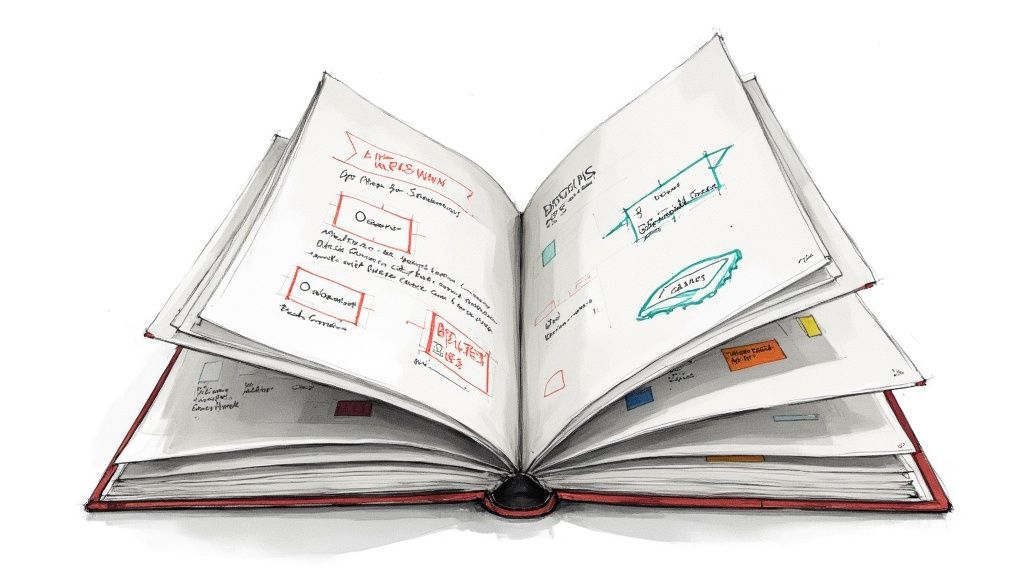
Quick Answer
What are the most effective book blurb styles in 2025?
The most effective book blurb styles include the Hook Opening (thriller/mystery), Character-Driven (romance/literary), and Stakes-Driven (all genres). Each style serves different genres and reader expectations. Success comes from matching your blurb style to your book's genre and core appeal, then executing it with precision.
Top 3 blurb styles to master:
- Hook Opening - Grabs attention instantly with shocking statements or mysteries
- Character-Driven - Creates emotional investment through relatable protagonists
- Stakes-Driven - Emphasizes consequences to create urgency and tension
For detailed formulas and step-by-step instructions, see our 8 book description formulas guide or our how-to write a blurb tutorial.
Unlocking the Power of the Blurb
A compelling book blurb is your secret weapon for attracting readers. It's the short, persuasive pitch that convinces potential buyers to click "add to cart." If you're new to blurbs, start with our complete definition and 10 real examples guide to understand the fundamentals. This article provides a curated selection of effective book blurb examples, analyzing six distinct styles that work across various genres. We'll dissect what makes them work, offering actionable strategies you can implement in your own marketing.
We'll analyze six distinct blurb styles:
- The Hook Opening Blurb
- The Testimonial-Heavy Blurb
- The Character-Driven Blurb
- The Question-Based Blurb
- The Comparison Blurb
- The Stakes-Driven Blurb
Each example will be broken down strategically, highlighting the "why" behind its success. You'll gain practical takeaways to craft blurbs that convert browsers into buyers. A strong blurb isn't just about summarizing the plot; it's about capturing the essence of your story and making an emotional connection. This is crucial for authors, publishers, and marketers seeking effective promotion.
By mastering the art of the blurb, you give your book the best chance to stand out in a crowded marketplace. Learn how to make your book blurb irresistible with these insightful book blurb examples and proven formulas you can implement immediately.
1. The Hook Opening Blurb
The Hook Opening Blurb is a powerful technique for crafting compelling book blurbs. It prioritizes immediate engagement by starting with the most captivating element of the story - a gripping question, a shocking statement, or a scene of high drama. This approach bypasses lengthy introductions and dives straight into the heart of the narrative, instantly hooking the reader's curiosity before providing further context. It's like dangling a delicious plot point in front of the reader and then promising to reveal the full story. It makes them crave more.
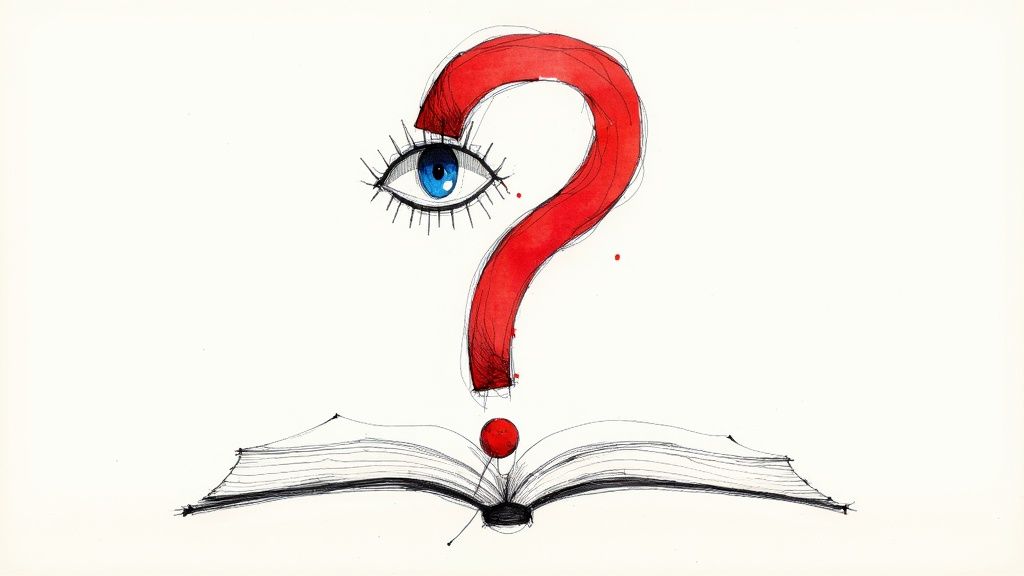
Examples of Hook Opening Blurbs in Action
Two prime examples of the Hook Opening Blurb done right are Gillian Flynn's Gone Girl and Stieg Larsson's The Girl with the Dragon Tattoo. Gone Girl opens with, "On the morning of his fifth wedding anniversary, Nick's wife Amy suddenly disappears." This instantly creates a sense of mystery and suspense. Who is Nick? What happened to Amy? Readers are immediately drawn in. Similarly, The Girl with the Dragon Tattoo begins: "Forty years ago, Harriet Vanger disappeared from a family gathering on the island owned by the powerful Vanger clan." This opening line establishes a long-standing mystery, hinting at family secrets and a powerful, potentially dangerous family dynasty.
Crafting Your Own Hook Opening Blurb: Tips and Best Practices
Creating a compelling hook opening requires careful consideration and testing. Here's how to maximize its impact:
- Test different hooks: Present several opening lines to your target audience and gather feedback on which ones resonate most strongly. This helps ensure your hook is as effective as possible.
- Accuracy is key: While the hook should be dramatic, it must accurately reflect the book's overall tone and content. A misleading hook can lead to reader disappointment.
- Brevity is power: Aim for an opening under 20 words. A concise hook delivers maximum impact and is easily digestible for potential readers.
- Build on the intrigue: Follow the initial hook with supporting details that deepen the mystery and further entice readers. Don't leave them hanging for too long.
When and Why to Use the Hook Opening
The Hook Opening Blurb is especially effective for genres that thrive on suspense and intrigue, such as thrillers, mysteries, and suspense novels. It's also a useful technique for any book with a strong narrative hook or a compelling central question. This method prioritizes capturing attention in a crowded marketplace. The hook opening blurb is designed to draw readers in immediately with compelling content that demands attention. It's a strategic choice for authors and publishers seeking to create immediate interest and drive book sales. For more insights into crafting viral book hooks, explore our guide to crafting viral book hooks. This style, popularized by psychological thriller publishers, has become a staple in modern mystery novel marketing. Its effectiveness lies in its ability to tap into our innate curiosity and leave us wanting more.
2. The Testimonial-Heavy Blurb
The Testimonial-Heavy Blurb is a strategic approach to crafting compelling book blurbs. It leverages the power of social proof by showcasing positive reviews and endorsements from credible sources. This method builds trust and persuades potential readers by highlighting the book's value through the voices of established authors, respected publications, or subject matter experts. It's like having a chorus of voices vouching for your book's quality, instantly boosting its credibility and appeal.
Examples of Testimonial-Heavy Blurbs in Action
Literary debuts often utilize this tactic effectively. New authors gain instant credibility by featuring endorsements from established writers in the same genre. Imagine a debut fantasy novel with a blurb boasting praise from Brandon Sanderson. This immediately signals quality and attracts fantasy readers. Non-fiction books frequently feature academic or expert endorsements, further solidifying the book's authority and trustworthiness. Award-winning novels strategically display quotes about their recognition, emphasizing their acclaim and prestige.
Crafting Your Own Testimonial-Heavy Blurb: Tips and Best Practices
Maximize the impact of your testimonial-heavy blurb with these strategies:
- Limit to 3-4 endorsements: Too many quotes can overwhelm readers. Select the most impactful testimonials that highlight different aspects of the book.
- Include reviewer credentials: For less-known endorsers, briefly mention their relevant expertise or credentials. This adds weight to their opinions.
- Mix different types of sources: Include a variety of voices, such as authors, publications, and experts, to showcase broad appeal.
- Place the strongest endorsement first or last: These positions have the most impact and are more likely to be remembered.
When and Why to Use the Testimonial-Heavy Approach
This blurb style is particularly effective for:
- Debut authors: Testimonials provide instant credibility and help break into the market.
- Non-fiction books: Expert endorsements establish authority and build reader trust.
- Award-winning or critically acclaimed books: Showcasing recognition amplifies the book's prestige.
- Books targeting niche audiences: Testimonials from respected figures within the niche can significantly influence purchasing decisions.
This approach prioritizes establishing trust and demonstrating value. It's a strategic choice for authors and publishers aiming to leverage the influence of respected voices to boost book sales. This method also lends itself well to books that have garnered pre-publication buzz or have received positive early reviews. Its effectiveness lies in its ability to tap into our tendency to trust recommendations from credible sources, making it a powerful tool in the crowded book market. The Testimonial-Heavy Blurb provides a shortcut to building confidence in your book's quality.
3. The Character-Driven Blurb
The Character-Driven Blurb prioritizes introducing the protagonist and their journey, emphasizing character development and personal stakes. This style works by making readers emotionally invest in the character before revealing plot details. Creating this personal connection drives purchasing decisions. Readers are drawn to compelling characters facing relatable struggles, making them more likely to invest in the story's outcome. It's about selling the who as much as the what.
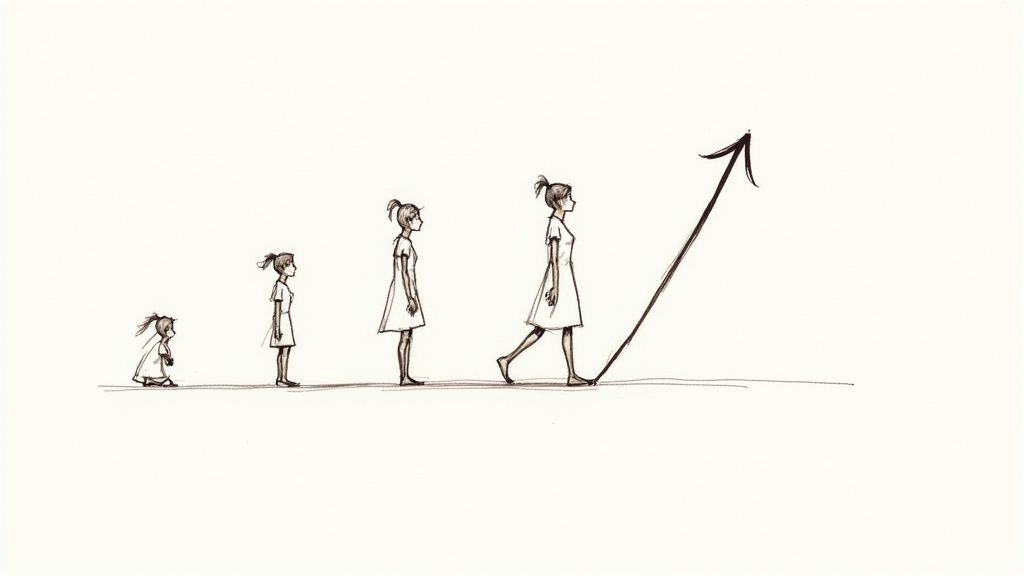
Examples of Character-Driven Blurbs in Action
Romance novels, coming-of-age stories, and women's fiction frequently employ this technique. Think about blurbs that highlight a character's defining traits or their emotional struggle. For example, a blurb might introduce a character grappling with a difficult decision, a hidden past, or a yearning for something more. These internal conflicts create immediate intrigue and invite readers to connect with the character's emotional landscape. This emotional resonance can be more powerful than a plot-heavy summary.
Crafting Your Own Character-Driven Blurb: Tips and Best Practices
Here's how to craft a character-driven blurb that resonates with readers:
- Introduce the character with specific, relatable details: Avoid generic descriptions. Instead, use details that paint a vivid picture of their personality and circumstances.
- Highlight what makes your protagonist unique: What sets your character apart? What are their strengths, flaws, and motivations?
- Show the character's stakes and what they risk losing: Raising the stakes creates tension and investment. What does your character stand to gain or lose?
- End with a hint of the transformation to come: Without giving away the ending, suggest the potential for growth or change. This adds another layer of intrigue.
When and Why to Use the Character-Driven Approach
This approach excels in genres where emotional connection is paramount, such as romance, literary fiction, and young adult. It's about drawing readers into the character's world and making them care about their journey. When readers feel invested in the character, they're more likely to follow them anywhere. This blurb style is particularly effective when dealing with complex characters or internally driven narratives.
This style was popularized by romance publishers like Harlequin and has been adopted by women's fiction and young adult novel promoters. Its effectiveness lies in its ability to tap into our innate desire for connection and empathy. For more information on crafting an effective blurb, check out our complete guide to book blurbs covering character-driven techniques and other successful approaches. Crafting a compelling character-driven blurb is a powerful way to stand out in a crowded market and connect with readers on a deeper level. It's about offering a glimpse into the heart and soul of your protagonist, inviting readers to share in their experiences and become invested in their destiny.
4. The Question-Based Blurb
The Question-Based Blurb is a dynamic approach to crafting compelling book descriptions. It leverages the power of inquiry, posing a series of thought-provoking questions that directly mirror the reader's potential curiosity and the book's core mysteries or conflicts. This format actively engages readers by drawing them into the questioning process, making them feel like participants in unraveling the answers hidden within the book's pages. It transforms a passive reading experience into an active quest for knowledge.
Examples of Question-Based Blurbs in Action
Consider a mystery novel blurb asking, "Who can be trusted?" and "What really happened that night?" These questions immediately ignite intrigue and suspicion, prompting readers to seek the truth. Similarly, a self-help book might pose the question, "What if you could change your life in 30 days?" This taps into the reader's desire for self-improvement, offering a tantalizing promise of transformation. Even historical fiction can benefit from this technique, exploring dilemmas like, "How far would you go to protect your family?" This question evokes powerful emotions and sets the stage for a story of sacrifice and resilience. These book blurb examples highlight the versatility of this technique.
Crafting Your Own Question-Based Blurb: Tips and Best Practices
To maximize the effectiveness of a question-based blurb, consider these key strategies:
- Intrigue, not obviousness: The questions should be genuinely intriguing, not easily answered or predictable. They should spark curiosity and a desire to delve deeper.
- Build momentum: Structure the questions from simple to complex, gradually increasing the level of intrigue and suspense.
- Answer the call: Ensure your book actually answers the questions posed in the blurb. A disconnect between the questions and the content can lead to reader disappointment.
- Less is more: Limit the number of questions to three or four. Too many questions can overwhelm the reader and dilute the impact.
When and Why to Use the Question-Based Approach
This blurb style is particularly effective for genres that thrive on suspense, such as mysteries, thrillers, and suspense novels. It's also a powerful tool for self-help books, where questions can tap into readers' desires for improvement and change. Historical fiction, particularly stories involving moral dilemmas or complex family dynamics, can also benefit from this approach. Essentially, the question-based blurb excels at engaging readers by directly involving them in the narrative's central questions. This style of blurb, often utilized by self-help book marketers and publishers of mysteries and thrillers, creates an interactive experience for potential readers, transforming them from passive observers to active participants in the quest for answers. Its success hinges on tapping into human curiosity and the inherent desire to solve puzzles. The question-based blurb provides an effective blueprint for authors and publishers striving to capture attention and drive book sales by offering a taste of the intellectual and emotional journey that awaits within the pages of their book. It directly invites the reader to engage with the core themes and conflicts, creating a sense of anticipation and a desire to uncover the truth.
5. The Comparison Blurb
The Comparison Blurb is a strategic marketing approach that leverages the familiarity of established books and authors to position a new title in the market. It uses phrases like "meets," "for fans of," or "in the tradition of" to draw parallels and help potential readers quickly grasp the book's genre, style, and overall appeal. By referencing familiar literary touchstones, this method provides a convenient shorthand for conveying a book's essence, particularly for readers browsing online or in bookstores. It's a powerful tool for grabbing attention and piquing interest in a crowded marketplace.
Examples of Comparison Blurbs in Action
Several recent book blurbs effectively utilize the comparison strategy. "For fans of Gillian Flynn and Tana French" immediately signals a psychological thriller with complex characters and dark themes. "The Handmaid's Tale meets Black Mirror" suggests a dystopian narrative with social commentary and technological anxieties. "Perfect for readers who loved Where the Crawdads Sing" targets readers drawn to coming-of-age stories with strong female protagonists and atmospheric settings. These comparisons provide instant context and help readers visualize the book's experience.
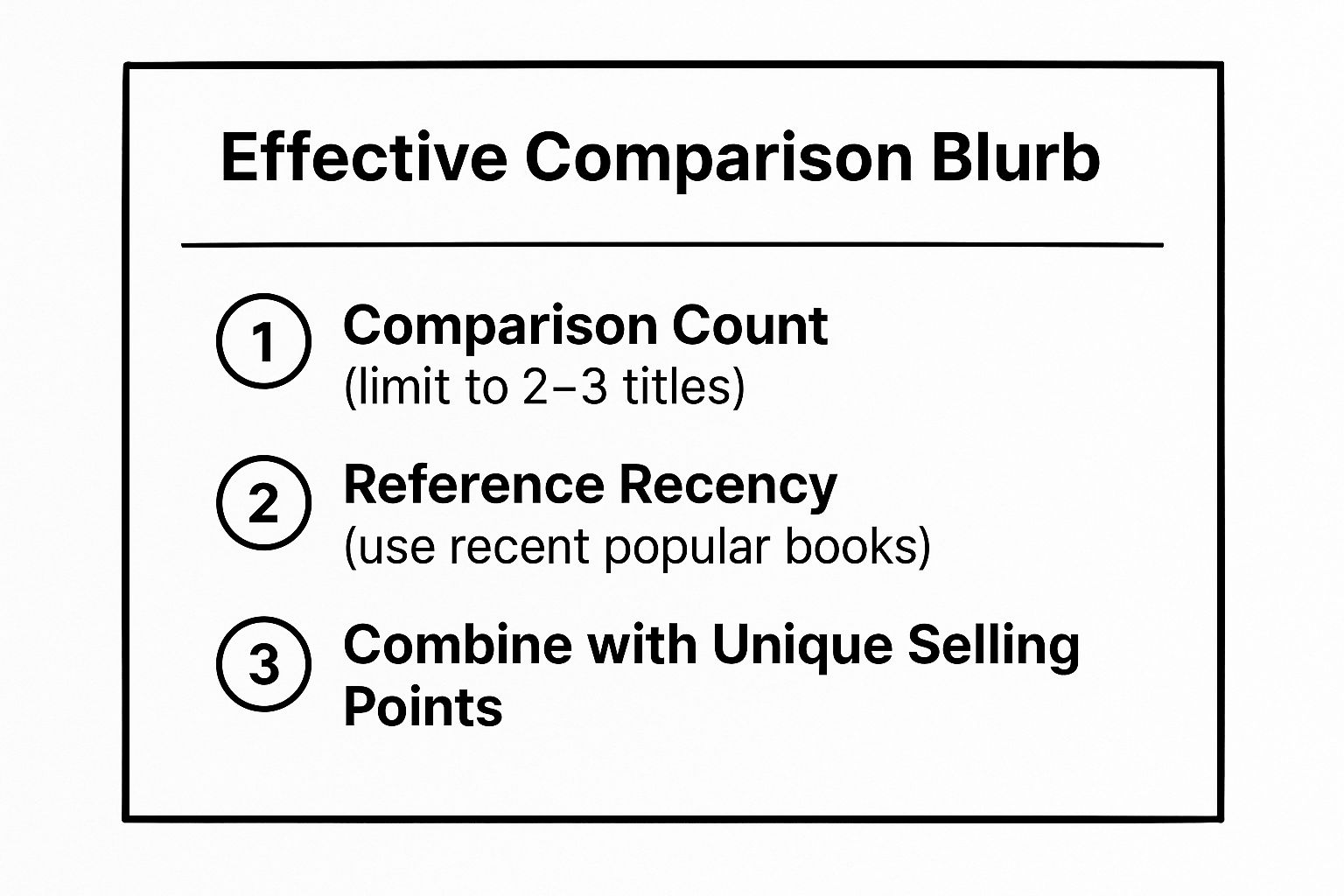
This infographic summarizes three key aspects for crafting impactful Comparison Blurbs: limiting the number of comparisons, referencing recent releases, and highlighting the book's unique elements alongside the comparisons. As the infographic illustrates, striking the right balance between familiarity and originality is crucial for maximizing the effectiveness of this technique.
Crafting Your Own Comparison Blurb: Tips and Best Practices
Using comparisons effectively requires thoughtful consideration. Choosing accurate and relevant comparisons is paramount. The compared titles should genuinely reflect your book's tone and style, avoiding misleading potential readers. Select recently published and widely popular books to ensure your target audience recognizes the references. Limit comparisons to two or three to prevent confusion and maintain clarity. Finally, combine comparisons with your book's unique selling points to showcase originality and avoid appearing derivative.
When and Why to Use the Comparison Blurb
The Comparison Blurb is especially valuable for debut authors or books entering a competitive genre. It provides a readily understandable framework for positioning the book within the existing literary landscape. This method is also useful for books that blend genres or defy easy categorization. By drawing comparisons to established works, authors can bridge the gap for readers and clarify the book's identity. This strategy, frequently used by publishing houses and literary agents, offers a quick and effective way to communicate a book's essence and attract the right audience. Learn more about researching comparable titles for your book to find the perfect comparisons. Its widespread use demonstrates its effectiveness in capturing attention and driving book discovery. This method allows authors to tap into the power of association and instantly connect with readers seeking similar literary experiences.
6. The Stakes-Driven Blurb
The Stakes-Driven Blurb is a powerful tool for grabbing reader attention by clearly outlining what the protagonist stands to gain or lose. This technique creates immediate tension and urgency, making it clear why readers should invest their time in the story. By emphasizing the potential consequences of the protagonist's actions (or inaction), the stakes-driven blurb transforms a simple plot summary into a compelling invitation to experience a high-stakes narrative. It answers the crucial question: "Why should I care?"
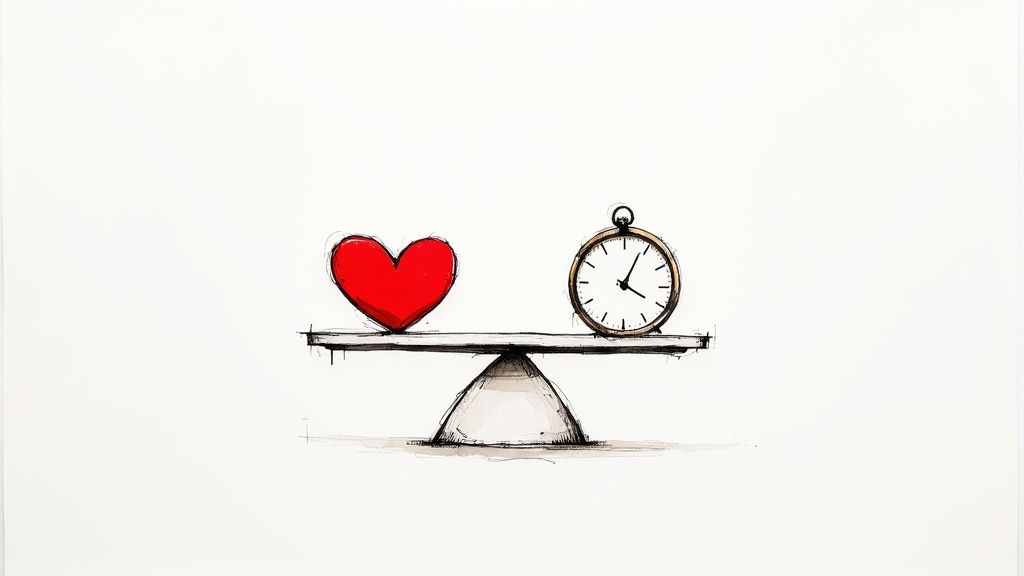
Examples of Stakes-Driven Blurbs in Action
Consider political thrillers. These often employ stakes-driven blurbs emphasizing national security consequences. Think of Tom Clancy's works, where the fate of nations hangs in the balance. Romance novels also effectively use this technique, highlighting the intense emotional risks and potential relationship rewards. Similarly, business books often outline the career and financial implications of following the advice within, appealing to readers' desire for professional success.
Crafting Your Own Stakes-Driven Blurb: Tips and Best Practices
Creating a compelling stakes-driven blurb requires a strategic approach. Here's how to maximize its impact:
- Make stakes personal and relatable: Connect the potential outcomes to the reader's own desires and fears.
- Layer multiple types of stakes: Don't just focus on physical danger. Explore emotional, social, or professional consequences as well. This adds depth and complexity.
- Ensure stakes are proportional: The consequences should match the scope of the story. Saving the world carries higher stakes than winning a local baking competition.
- Show both positive and negative outcomes: Highlight not only what the protagonist stands to lose, but also what they might gain. This creates a powerful push-pull dynamic.
When and Why to Use the Stakes-Driven Approach
The Stakes-Driven Blurb is particularly effective for genres where the consequences of actions are central to the narrative, such as thrillers, romances, and self-help books. It's a technique for any book where the protagonist faces a significant decision with far-reaching ramifications. This method focuses on the core driver of many narratives: conflict. By clearly articulating the potential outcomes, you give readers a compelling reason to invest in the journey.
This style, popularized by political thriller authors like Tom Clancy and high-stakes romance publishers, has proven effective in capturing reader interest. Business and self-improvement book marketers also frequently leverage this approach. Its strength lies in its ability to tap into our innate desire for meaningful outcomes and our aversion to loss, making the book impossible to resist. The Stakes-Driven Blurb is an invaluable tool for authors and publishers seeking to highlight the core conflict of their story and drive book sales by making the potential rewards and consequences crystal clear. It answers the reader's fundamental question: "What's in it for me?" It's a strategic approach that positions the book not just as entertainment but as a journey with tangible and compelling stakes. Crafting effective book blurb examples involves presenting compelling content that entices readers. The stakes-driven blurb does precisely this by highlighting the central conflicts and potential outcomes of the narrative.
6 Blurb Style Comparison Table
| Blurb Style | Implementation Complexity 🔄 | Resource Requirements 🔄 | Expected Outcomes 📊 | Ideal Use Cases 💡 | Key Advantages ⭐ |
|---|---|---|---|---|---|
| The Hook Opening Blurb | Moderate – craft a strong opening line | Low – focus on writing skills | High engagement and curiosity | Thriller, Mystery, Psychological Fiction | Captures attention quickly; emotional pull |
| The Testimonial-Heavy Blurb | High – gather credible endorsements | High – requires networking | Builds strong credibility | Literary Fiction, Non-fiction, Academic | Provides social proof; overcomes skepticism |
| The Character-Driven Blurb | Moderate – detailed character focus | Moderate – strong storytelling | Strong emotional connection to protagonist | Romance, Women’s Fiction, Young Adult | Appeals to readers valuing character depth |
| The Question-Based Blurb | Low – structure sentences as questions | Low – creative phrasing only | Highly engaging; builds suspense | Mystery, Self-help, Historical Fiction | Interactive; encourages reader curiosity |
| The Comparison Blurb | Moderate – select relevant comparisons | Moderate – research popular titles | Clear genre positioning; attracts target fans | Genre Fiction, Debut Novels | Quickly communicates style and appeal |
| The Stakes-Driven Blurb | Moderate – articulate clear stakes | Moderate – requires plot clarity | Creates urgency and emotional investment | Thriller, Romance, Business, Political Fiction | Drives tension; motivates reader interest |
Frequently Asked Questions
What makes a book blurb effective?
An effective book blurb captures attention immediately, creates emotional connection, clearly communicates the book's unique value, and ends with intrigue that compels readers to purchase.
The best blurbs match style to genre, use active voice, stay under 150-200 words, and include specific details rather than generic descriptions. Research shows well-crafted blurbs can boost conversion rates by 20-30% compared to generic summaries.
How long should a book blurb be?
Book blurbs should be 150-200 words or roughly 3-4 short paragraphs. Amazon allows up to 4,000 characters for book descriptions, but readers typically decide within the first 100 words whether to keep reading.
The sweet spot is concise enough to maintain attention but detailed enough to convey your book's unique appeal. Mobile readers especially appreciate brevity, as longer blurbs require scrolling.
What are the most effective book blurb styles?
The six most effective book blurb styles are:
- Hook Opening - Starts with shocking statement or mystery (best for thrillers)
- Testimonial-Heavy - Uses social proof from credible sources (debuts, literary fiction)
- Character-Driven - Emphasizes protagonist's journey (romance, women's fiction)
- Question-Based - Poses intriguing questions (mystery, self-help)
- Comparison - Positions book similar to bestsellers (debut novels, genre fiction)
- Stakes-Driven - Highlights what protagonist stands to gain or lose (works across all genres)
Match your style to your genre and book's core appeal for maximum effectiveness.
Should I include spoilers in my book blurb?
Never include spoilers in your book blurb. Your blurb should create intrigue and raise questions, not answer them. Focus on setup and stakes rather than resolution.
Reveal your protagonist's challenge and what they risk, but leave the outcome mysterious. Think of your blurb as a movie trailer—it shows enough to create excitement without revealing the ending. Readers want to discover the story themselves.
How do I write a book blurb for my specific genre?
Match your blurb style to genre expectations:
- Thrillers - Use Hook Opening or Stakes-Driven styles emphasizing danger and urgency
- Romance - Character-Driven blurbs highlighting emotional stakes and relationship conflicts
- Literary fiction - Character-Driven or Testimonial-Heavy approaches
- Non-fiction - Lead with the problem you solve and results readers gain
- Mystery - Question-Based formats work exceptionally well
- Self-help - Question-Based or Stakes-Driven showing transformation potential
Study bestselling books in your genre to identify patterns, then adapt these proven styles to your story.
Can book blurb templates help me write better descriptions?
Yes, book blurb templates provide proven structures, but customize extensively for your specific story. Templates help ensure you include essential elements like hook, character introduction, stakes, and conflict.
However, generic template language feels impersonal. Use templates as scaffolding, then infuse your unique voice and specific story details. Tools like ManuscriptReport's Marketing Report analyze your manuscript to generate customized blurb variations based on your actual content, saving time while maintaining authenticity.
Turning Blurbs into Book Sales
Throughout this article, we've explored six distinct book blurb examples, dissecting their underlying strategies and highlighting actionable takeaways. We've seen how a compelling hook can immediately grab a reader's attention, much like the "Hook Opening Blurb" example. We've analyzed the power of social proof using testimonials, as demonstrated in the "Testimonial-Heavy Blurb". We delved into character-driven narratives, question-based intrigue, comparative positioning, and stakes-driven suspense, all illustrated with concrete examples. Each blurb style offers a unique approach to capturing reader interest and conveying the essence of a book.
Key Takeaways for Effective Blurbs
Here's a recap of the most important elements to consider when crafting your own compelling book blurbs:
- Understand your target audience - Tailor language and focus to their specific interests and genre expectations
- Highlight the unique selling proposition - What makes your book different from the thousands of others?
- Create an emotional connection - Evoke curiosity, excitement, or intrigue that resonates deeply
- Keep it concise - 150-200 words is the sweet spot for maximum impact
- Match style to genre - Use Hook Opening for thrillers, Character-Driven for romance, Stakes-Driven universally
- Test and refine - Experiment with different versions to see what converts best
- Never include spoilers - Create intrigue, don't resolve it
Why Mastering Blurbs Matters for Book Sales
A strong blurb can mean the difference between a book that sits unnoticed and one that flies off the shelves. Research shows well-crafted blurbs boost conversion rates by 20-30% compared to generic descriptions.
Your blurb isn't just a summary—it's a powerful sales tool that transforms browsing readers into eager buyers. It works 24/7, selling your book on Amazon, in bookstores, and across social media. Master this skill once, and every book you publish benefits.
Your Next Steps to Blurb Mastery
Ready to create blurbs that sell? Follow this proven process:
- Identify your book's core appeal - What's the one thing that makes it irresistible?
- Choose your blurb style - Match it to your genre using the examples above
- Write 3-5 variations - Test different hooks and angles
- Get feedback - Share with beta readers and track which version they prefer
- Implement and measure - Use your best version and monitor conversion rates
Automate Your Blurb Creation Process
Creating multiple blurb variations manually can take hours. Looking for a faster, more effective approach?
ManuscriptReport's Marketing Report analyzes your manuscript to extract the most compelling hooks, character arcs, and stakes—then generates multiple blurb variations optimized for your specific genre. You get professional-quality blurbs in minutes instead of hours of trial and error.
Starting from only $25, it's more affordable than a single hour with a marketing consultant and includes everything you need for launch: blurbs, synopses, ad copy, keywords, target audience analysis, and more. Trusted by 1,000+ authors and publishers, it's the fastest way to create professional marketing materials that convert.
For complete marketing coverage, explore our comprehensive book marketing services designed specifically for indie and traditional authors who want professional results without the professional price tag.
Master every aspect of book descriptions:
- Formula breakdowns: 8 Book Description Examples - Detailed templates and structures
- Step-by-step guide: How to Write a Book Blurb - Complete tutorial from scratch
- Understanding blurbs: What is a Blurb? - Essential concepts and principles
- AI assistance: Auto-Generate Book Blurb with AI - Modern automation tools
Transform your browsing readers into buying customers with blurbs that sell.
Related Articles

The Ultimate Affordable Book Launch Checklist: 9 Essential Steps for 2025
Complete affordable book launch checklist for 2025. Follow 9 proven steps—from budget planning to post-launch—for indie and self-published authors. Launch successfully for under $500.
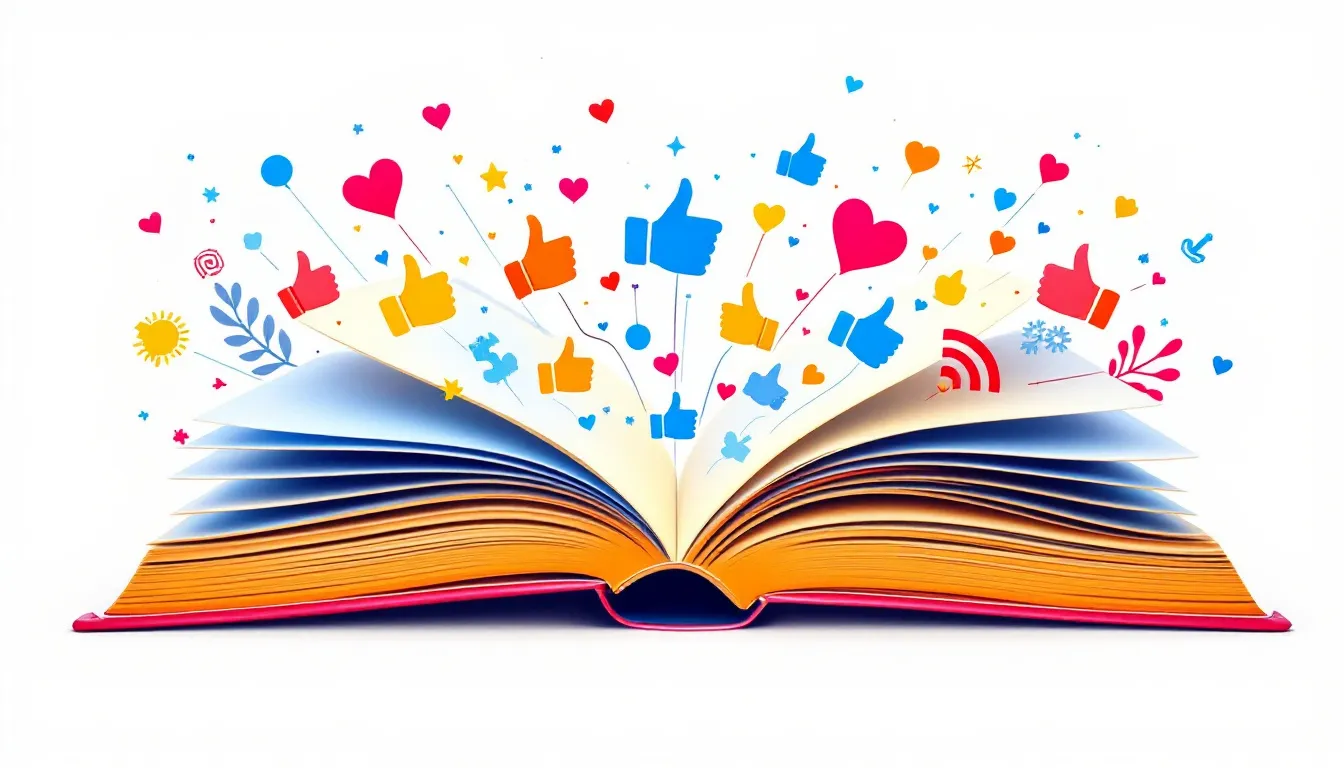
How to Write Viral Book Hooks: 10 Proven Strategies for Social Media Success
Master the art of viral book hooks with 10 proven strategies, platform-specific tactics, and templates that grab attention on BookTok, Instagram, and beyond.

7 Must-Have AI Writing Tools for Authors
Discover essential AI writing tools for authors to boost creativity and streamline marketing. Learn actionable tips and explore solutions like ManuscriptReport.com.